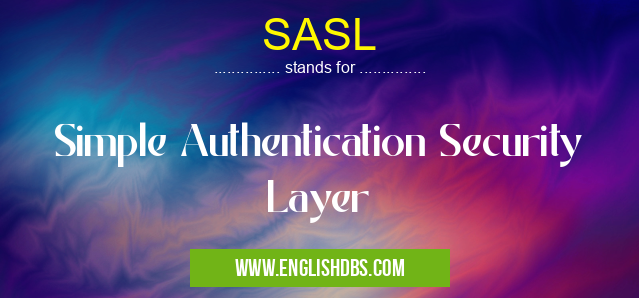What does SASL mean in UNCLASSIFIED
SASL stands for Simple Authentication and Security Layer. It is a type of technology used to add an extra layer of security during the authentication process when user connect their devices to networks, websites or applications. It is designed to provide a secure login method that enables users to access restricted data in systems and protects data from unauthorized access.

SASL meaning in Unclassified in Miscellaneous
SASL mostly used in an acronym Unclassified in Category Miscellaneous that means Simple Authentication Security Layer
Shorthand: SASL,
Full Form: Simple Authentication Security Layer
For more information of "Simple Authentication Security Layer", see the section below.
What is SASL
SASL is an authentication framework which provides a collection of mechanisms for verifying user credentials such as username and password combinations. This allows infrastructure providers to design access control systems that are tailored to their individual needs and can be updated with new data if needed. In addition, SASL also offers added protections such as message integrity checks, encryption methods, digital signatures, and other key-exchange algorithms that ensure that only authorized users can gain access to protected resources. Moreover, SASL can also be used to help secure communication channels by using strong cryptographic methods when sending messages between two remote systems.
Benefits of SASL
The primary benefit for organizations utilizing SASL is the enhanced security it offers over traditional authentication methods like passwords alone. By introducing an additional layer of authentication through various mechanisms like challenge-response protocols, digital signatures and encryption algorithms, businesses are better protected against unauthorized access attempts and malicious actors. Furthermore, because SASL can be implemented quickly and seamlessly into existing system infrastructures without substantial cost or disruption, it makes it an attractive security solution for companies looking for comprehensive protection without breaking the bank.
Essential Questions and Answers on Simple Authentication Security Layer in "MISCELLANEOUS»UNFILED"
What is SASL?
Simple Authentication Security Layer (SASL) is an authentication framework that allows clients to authenticate to a service using various mechanisms. This provides a unified way for applications to authenticate with each other, regardless of the underlying authentication protocols in use.
What are the benefits of using SASL?
Using SASL provides several benefits, such as improved security by relying on strong identity verification mechanisms, increased reliability and flexibility through support for multiple authentication protocols, and improved usability by making authentication simpler and more secure.
How does SASL work?
SASL works by providing a framework for exchanging messages between clients and services. A client wishing to authenticate will send an initial message containing the chosen authentication protocol and its credentials to the service. The service can then verify these credentials with the available mechanism, and if successful, will send an acknowledgement response back to the client.
What are some popular SASL protocols?
Some popular SASL protocols include Kerberos, OAuth2, OpenID Connect, SAML 2.0, DIGEST-MD5, CRAM-MD5, PLAIN and SCRAM-SHA-1.
Does my application need to support all of these protocols?
No, your application only needs to support those protocols which its intended users may use. It is important that you understand which authentication methods are used by users so that you can configure your application appropriately.
Are there any risks associated with using SASL?
As with all things related to computer security, there are certain risks associated with using an authentication system like SASL. It is important that proper precautions be taken when configuring your application's settings so that it remains secure from potential attacks or unauthorized access attempts. Additionally, you should also make sure that users keep their passwords secure at all times so as not to compromise their accounts' security.
Are there any tools or libraries I could use for implementing SASL in my web applications or services?
Yes indeed! There are many open source tools or libraries available for helping developers implement SASL in their applications or services. Examples include Apache Shiro, JavaGSSAPI Library, Akka Security Solution Kit etc.
Do I need any experience before attempting code implementation of a particular protocol within SASL?
While prior knowledge and coding experience may be advantageous while attempting code implementation of a particular protocol within SASL; depending upon the programming language being used - it may be possible for developers with little coding background or experience get up and running quickly too!
Final Words:
In conclusion, Simple Authentication and Security Layer (SASL) is a powerful tool for protecting businesses from unauthorized access attempts and other malicious activities by adding an additional layer of security on top of traditional authentication processes. Its efficient implementation and adjustable capabilities make it ideal for organizations looking for a cost-effective way to guard their networks and data stores — regardless of industry or size — while still providing convenient access to authorized users.
